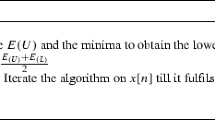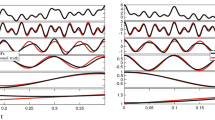Abstract
A novel sifting method based on the concept of the ‘local centroids’ of a signal is developed for empirical mode decomposition (EMD), with the aim of reducing the mode-mixing effect and decomposing those modes whose frequencies are within an octave. Instead of directly averaging the upper and lower envelopes, as suggested by the original EMD method, the proposed technique computes the local mean curve of a signal by interpolating a set of ‘local centroids’, which are integral averages over local segments between successive extrema of the signal. With the ‘centroid’-based sifting, EMD is capable of separating intrinsic modes of oscillatory components with their frequency ratio ν even up to 0.8, thus greatly mitigating the effect of mode mixing and enhancing the frequency resolving power. Inspection is also made to show that the integral property of the ‘centroid’-based sifting can make the decomposition more stable against noise interference.
Similar content being viewed by others
References
Cohen, L., 1989. Time-frequency distributions-a review. Proc. IEEE, 77(7):941–981. [doi:10.1109/5.30749]
Datig, M., Schlurmann, T., 2004. Performance and limitations of the Hilbert-Huang Transformation (HHT) with an application to irregular water waves. Ocean Eng., 31(14–15):1783–1834. [doi:10.1016/j.oceaneng.2004.03.007]
Deering, R., 2006. Final-Scale Analysis of Speech Using Empirical Mode Decomposition: Insight and Applications. PhD Thesis, Duke University, Durham, America.
Deering, R., Kaiser, J.F., 2005. The Use of a Masking Signal to Improve Empirical Mode Decomposition. Proc. IEEE ICASSP, 4:485–488. [doi:10.1109/ICASSP.2005.1416051]
Hlawatsch, F., Boudreaux-Bartels, G.F., 1992. Linear and quadratic time-frequency signal representation. IEEE Signal Process. Mag., 9(2):21–67. [doi:10.1109/79.127284]
Huang, N.E., Wu, Z., 2007. An adaptive data analysis method for nonlinear and nonstationary time series: the empirical mode decomposition and Hilbert spectral analysis. Wavelet Anal. Appl., 1(4):363–376. [doi:10.1007/978-3-7643-7778-6_25]
Huang, N.E., Shen, Z., Long, S.R., Wu, M.C., Shih, H.H., Zheng, Q., Yen, N.C., Tung, C.C., Liu, H.H., 1998. The empirical mode decomposition and the Hilbert spectrum for nonlinear non-stationary time series analysis. Proc. Roy. Soc. A, 454(1971):903–995.
Huang, N.E., Shen, Z., Long, S., 1999. A new view of nonlinear water waves: the Hilbert Spectrum. Ann. Rev. Fluid Mech., 31:417–459. [doi:10.1146/annurev.fluid.31.1.417]
Huang, N.E., Chern, C.C., Huang, K., Salvino, L.W., Long, S., Fan, K.L., 2001. A new spectral representation of earthquake data: Hilbert spectral analysis of Station TCU129, Chi-Chi, Taiwan, 21 September 1999. Bull. Seismol. Soc. Am., 91(5):1310–1338. [doi:10.1785/0120000735]
Kopsinis, Y., McLaughlin, S., 2008a. Investigation and performance enhancement of the empirical mode decomposition method based on a heuristic search optimization approach. IEEE Trans. Signal Process., 56(1):1–13. [doi:10.1109/TSP.2007.901155]
Kopsinis, Y., McLaughlin, S., 2008b. Improved EMD using doubly-iterative sifting and high order spline interpolation. EURASIP J. Adv. Signal Process., 2008:1–8. [doi:10.1155/2008/128293]
Laila, D.S., Messina, A.R., Pal, B.C., 2009. A refined Hilbert-Huang transform with applications to interarea oscillation monitoring. IEEE Trans. Power Syst., 24(2):610–620. [doi:10.1109/TPWRS.2009.2016478]
Liang, H., Lin, Z., McCallum, R.W., 2000. Artifact reduction in electrogastrograms based on the empirical mode decomposition. Med. Biol. Eng. Comput., 38(1):35–41. [doi:10.1007/BF02344686]
Messina, A.R., 2009. Inter-Area Oscillations in Power Systems: a Nonlinear and Nonstationary Perspective. Springer, Berlin, Germany. [doi:10.1007/978-0-387-89530-7]
Rilling, G., Flandrin, P., 2008. One or two frequencies? The empirical mode decomposition answers. IEEE Trans. Signal Process., 56(1):85–95. [doi:10.1109/TSP.2007. 906771]
Schlurmann, T., Dose, T., Schimmels, S., 2001. Characteristic Modes of the ‘Adreanov Tsunami’ Based on the Hilbert-Huang Transformation. Proc. 4th Int. Symp. on Ocean Wave Measurement and Analysis, 2:1525–1534. [doi:10.1061/40604(273)154]
Senroy, N., Suryanarayanan, S., Ribeiro, P.F., 2007. An improved Hilbert-Huang method for analysis of timevarying waveforms in power quality. IEEE Trans. Power Syst., 22(4):1843–1850. [doi:10.1109/TPWRS.2007.907542]
Xuan, B., Xie, Q., Peng, S., 2007. EMD sifting based on bandwidth. IEEE Signal Process. Lett., 14(8):537–540. [doi:10.1109/LSP.2007.891833]
Author information
Authors and Affiliations
Corresponding author
Additional information
Project supported by the National Natural Science Foundation of China (No. 10574070) and the State Key Laboratory Foundation of China (No. 9140C240207060C24)
Rights and permissions
About this article
Cite this article
Hong, H., Wang, Xl., Tao, Zy. et al. Centroid-based sifting for empiricalmode decomposition. J. Zhejiang Univ. - Sci. C 12, 88–95 (2011). https://doi.org/10.1631/jzus.C1000037
Received:
Accepted:
Published:
Issue Date:
DOI: https://doi.org/10.1631/jzus.C1000037
Key words
- Sifting
- Empirical mode decomposition (EMD)
- Mode mixing effect
- Frequency resolution
- Local centroids
- Noise resistance




